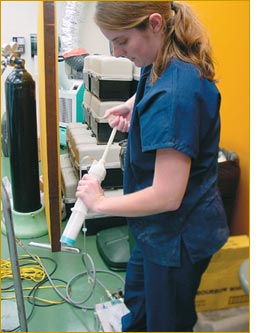

Zimmer engineer and Notre Dame graduate Sarah Thelen prepares bone cement as part of the cadaver testing procedure. A large portion of the bioengineering initiative at Notre Dame is the result of its strong partnership with Zimmer, Inc. A leader in the design, manufacture, and distribution of orthopedic implants and fracture management products, Zimmer is located less than an hour from the University. |
Bioengineering at Notre Dame
 Building bridges, designing manufacturing systems, studying the aerodynamic
properties of airplanes, and developing more powerful, more efficient engines … those
are the types of activities traditionally considered part of the realm
of engineering. “Engineers don’t work with living systems.
That’s the job of biologists.” Or is it? According to the Obligation
of an Engineer pledge, similar in nature to the Hippocratic oath taken
by physicians, an engineer promises to uphold the standards and dignity
of the profession and to serve humanity by making the best use of his or
her talents and the Earth’s resources. The pledge places no limits
on how an engineer can contribute.
Building bridges, designing manufacturing systems, studying the aerodynamic
properties of airplanes, and developing more powerful, more efficient engines … those
are the types of activities traditionally considered part of the realm
of engineering. “Engineers don’t work with living systems.
That’s the job of biologists.” Or is it? According to the Obligation
of an Engineer pledge, similar in nature to the Hippocratic oath taken
by physicians, an engineer promises to uphold the standards and dignity
of the profession and to serve humanity by making the best use of his or
her talents and the Earth’s resources. The pledge places no limits
on how an engineer can contribute.
What engineers, physicians, and biologists are finding is that, working together,
they can make a greater difference in the lives of people around the world
than by working separately. The unique skills and perspective offered by
each group are evident in the many multidisciplinary collaborations taking
place around the world.
Curricula, at Notre Dame and other universities across America, are also
changing to reflect the need for engineers to better understand the life
sciences and for biologists to better understand engineering and systems.
Traditional mind-sets are evolving, opening a world of possibilities and
collaborative opportunities.
The effort has only just begun, but the progress that has already been made
is staggering. The medical advances that have occurred, and those that are
on the verge of clinical studies and implementation, show that the lines
between engineering and biology, between medicine and mechanics, do not run
perpendicular to one another with a single intersecting point, one called
bioengineering. Rather, they are intertwined and will prove more and more
complementary to one another in the future, a future that offers a much higher
quality of life for everyone.